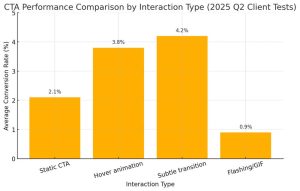Back
Top 6 web design myths
Web design myths continue to hold businesses back in 2025, despite being repeatedly debunked. I’ve worked with hundreds of clients on websites and digital strategy, and the same mistaken ideas persist. It’s time to address them properly.
Let’s cut through six of the most persistent myths and look at what really matters in 2025.
“Users don’t like to scroll, so everything must go above the fold”
This idea has been out of date for years. Users scroll instinctively. We scroll through social media, news apps, product pages, so why not websites?
Trying to cram everything above the fold leads to cluttered layouts and confusing messaging. The reality is this:
| Fold Placement | User Engagement | Conversion Impact |
|---|---|---|
| Above the fold | High visibility | Low if cluttered |
| Below the fold | Moderate | High if relevant |
The best-performing pages we build today balance clear messaging above the fold with deeper, scannable content below it. Our web design team builds responsive, user-friendly layouts that encourage scrolling with clarity, not chaos.
“The bigger my logo, the more they’ll trust my brand”
No one buys from you because your logo is large. They buy because your service, message or product resonates. When your logo takes over the hero section, you lose space for your actual value proposition.
Think of Amazon, Apple, or Nike. Their brand trust doesn’t come from the size of their logo; it comes from their customer experience. Instead of inflating your logo, focus on positioning your USP with strong creative. We do this through tight collaboration between our branding and design teams and our content and video specialists.
“We need a flashing call-to-action button to grab attention”
Flashing CTAs went out with dial-up. Visual noise doesn’t convert; it distracts.
That doesn’t mean your CTA should blend in. The trick is contrast and subtle interaction. Our UX designers use hover-triggered animation or movement to guide clicks. It’s far more effective than spinning graphics. When we combine this with focused content marketing and strategic consultancy, we help visitors act, not bounce.
Here’s what testing often shows:

CTA performance comparison based on 2025 Q2 client tests, showing which button styles convert best.
“Our new website went live yesterday, so the sales should start today”
This one always stings.
Launching a site is just the start. A new website without SEO, PPC, and social media support is like printing brochures and leaving them in the boot of your car.
Every project we launch comes with a full digital marketing strategy. From traffic acquisition to conversion optimisation, it’s about sustained effort. The truth is: most of your audience won’t even know your new site exists unless you tell them again and again.
“We need a separate mobile site”
In 2014, this was common. Now it’s a liability.
Responsive web design is the standard. You need one site that adapts intelligently to all devices. Mobile-only sites strip out content, break brand consistency and frustrate users.
Every site we build is responsive from the ground up. Whether it’s a B2C ecommerce project or a B2B virtual tour experience, we deliver full functionality on all screen sizes.
Google continues to prioritise mobile-first indexing, and responsive sites are its preference. More importantly, they’re your users’ preferences too.
“If I like my site, my customers will too”
You’re not your customer. I remind clients of this all the time.
It’s natural to care about your site. But personal taste isn’t the same as usability. We’ve had clients love a homepage design that users found confusing. That’s why we build around user personas, real insights about your customer journey.
We always recommend mapping at least three persona types. From there, our PR and communications, video and content teams create assets that match what your customers actually want to see and hear.
Ready to Fix the Web Design Mistakes Holding You Back?
Web design myths waste time, budget, and customer attention. At Purplex, we replace guesswork with strategic design, user-focused content, and campaigns that actually deliver results.
If you’re planning a new website or rethinking your current one, talk to us. We offer a full range of agency services, including web design, SEO, content marketing, and strategic consultancy.
Speak to a web design specialist today to get practical advice, review your current site, or start planning a future-proof digital strategy.
Call us on 01934 808132
Email us at grow@purplexmarketing.com
Office hours: Monday–Thursday, 9 am–5 pm. Friday, 9 am–4 pm (GMT)
Or contact us via our online form, and we’ll be in touch.
Let’s get your website working properly for your business and for your users.
This article was originally published on 21 October 2014 at 12:06 and has been fully updated on 4 August 2025 to reflect current practices, insights and services. The content was revised by Martyn East, a senior marketing strategist at Purplex with over 10 years’ experience in digital marketing, SEO and PPC.
This entry was posted in Web Development





